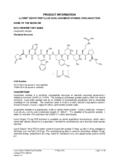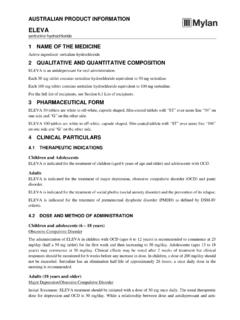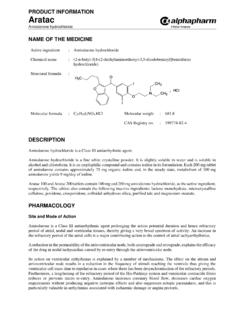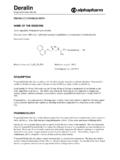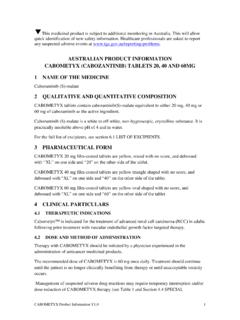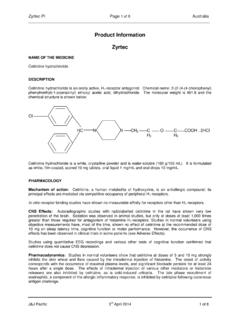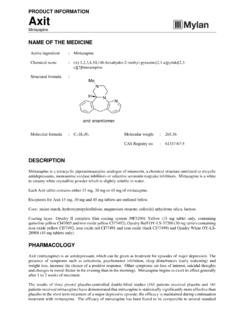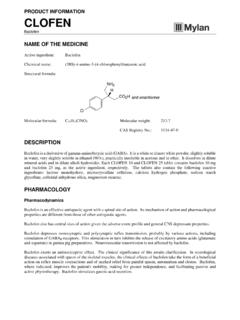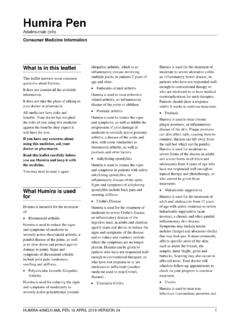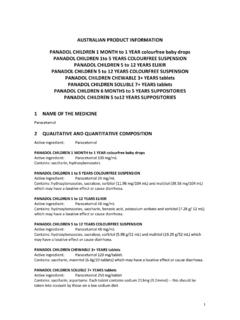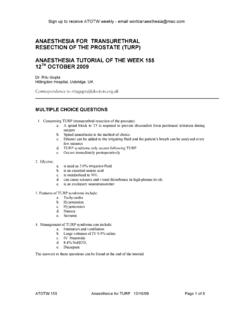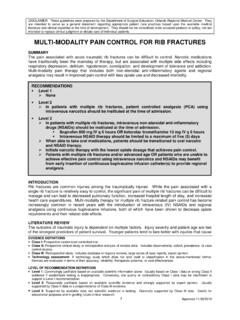Transcription of AUSTRALIAN PRODUCT INFORMATION TEMGESIC …
1 Page 1 of 10 TEMGESIC PRODUCT INFORMATION NAME OF THE MEDICINE TEMGESIC INJECTION and TEMGESIC SUBLINGUAL TABLETS Active Ingredient: Buprenorphine hydrochloride Chemically, buprenorphine is 21-Cyclopropyl-7 - (S) 1- hydroxy-1,2,2- trimethylpropyl -6,14-endo ethano-6,7,8,14-tetrahydrooripavine hydrochloride. Buprenorphine hydrochloride has the molecular formula C29 H41 NO4 HCl and the molecular weight is The CAS number is 53152-21-9. The chemical structure of buprenorphine is: DESCRIPTION Buprenorphine hydrochloride is a white powder, weakly acidic with limited solubility in water ( mg/mL at 37 C, pH ).
2 TEMGESIC is a synthetic opioid agonist-antagonistic analgesic. It is available in two dosage forms containing the active ingredient buprenorphine hydrochloride. Each 1mL of TEMGESIC Injection contains 300 micrograms of buprenorphine (as the hydrochloride), 55mg glucose (equivalent to 50mg anhydrous glucose), water for injections and hydrochloric acid to adjust the pH to approximately Each TEMGESIC Sublingual Tablet contains 216 micrograms of buprenorphine hydrochloride (equivalent to 200micrograms of buprenorphine). Each tablet also contains lactose monohydrate, mannitol, maize starch, povidone, magnesium stearate, citric acid and sodium citrate dihydrate.
3 PHARMACOLOGY Site and mode of action Buprenorphine is a -opioid partial agonist with high affinity for the -opioid receptor, demonstrating both agonist and antagonist properties. The drug receptor complex is very stable and dissociates slowly. Buprenorphine is also an antagonist at the -opioid receptor. Pharmacodynamics In a number of standard animal antinociceptive tests, buprenorphine displays potent analgesic activity, often with a curvilinear or bell-shaped dose-response in which 'higher' doses produce a lesser effect than 'lower' doses. In such tests, buprenorphine is more potent than other opioid analgesics, such as morphine (30x) and Page 2 of 10 pentazocine (100x) and at equi-analgesic doses the duration of action of buprenorphine in these animal tests is at least 4x as long as morphine.
4 Buprenorphine does not substitute for morphine in dependent rats; rather, it precipitates signs of abstinence and is at least as potent as naloxone in antagonising morphine-induced analgesia in rodents. In animal tests for physical dependence liability, buprenorphine has the least capability of any opioid tested, being lower than codeine and pentazocine. In chronically-treated primates neither abrupt withdrawal nor administration of narcotic antagonists could precipitate abstinence. In view of the receptor kinetics of buprenorphine, this is not an unexpected result.
5 Although buprenorphine produces initial immobility in rodents followed by increased locomotor activity, higher doses in primates produce only mild signs of CNS depression. Buprenorphine slightly decreases the respiratory rate in mice, cats and dogs. Arterial blood gas measurements in rats showed that buprenorphine, unlike morphine, has a bell-shaped dose-response curve in the dose range intra-arterially, with a ceiling effect such that the maximum depression of respiration seen with buprenorphine was significantly less than that with morphine. In man, respiratory depression in the CO2 response model increased linearly with doses up to , which was the highest tested.
6 The peak depressant effect with buprenorphine occurred at 3-5 hours compared to 1-2 hours with morphine. However, doses up to 7mg (equivalent to 200mg morphine) have been given to patients without clinically significant respiratory effects. Buprenorphine at high doses causes a slight reduction in heart rate in rats and dogs, but has little effect on arterial blood pressure. Major cardiovascular changes are unlikely to occur after therapeutic doses. At therapeutic doses, blood pressure and pulse rate may fall slightly, the maximum changes observed being 10-15%. A clinical trial of intravenous buprenorphine to treat chest pain associated with myocardial infarction showed no significant changes in systemic or pulmonary arterial blood pressure or in heart rate.
7 During the period of reduced cardiac reserve after open heart surgery, intravenous buprenorphine effected no significant changes in cardiac output, mean arterial pressure or peripheral resistance. Because of the stability of the complex formed between buprenorphine and the opioid receptor, antagonists are only partially effective in reversing the effect of established buprenorphine compared to the situation when the antagonist is administered prior to buprenorphine. At very high doses there is evidence from animal studies for developing tolerance to buprenorphine and cross tolerance with morphine Animal studies have shown evidence for a potentiation of action between buprenorphine and centrally-acting drugs likely to be used concurrently, such as halothane, fluothane and thiopentone sodium.
8 Pharmacokinetics Systemic availability of parenterally administered buprenorphine is generally close to 100%. Plasma levels in patients following an intravenous or intramuscular dose of 300 micrograms are maximal at 2 minutes and 5 minutes, respectively. At 10 minutes the plasma concentration from intramuscular and intravenous doses are essentially identical. The buprenorphine plasma level data achieved after these doses most closely fit a tri-exponential decay curve, with a very fast initial distribution phase (t 2 minutes) and a slow elimination phase (t approximately 5 hours). When buprenorphine is taken at much higher doses, for the treatment of opioid addiction, a long terminal elimination phase - half-life hours is observed.
9 This phase follows the elimination phase with the half-life of 5 hours and can not be measured following normal analgesic doses because plasma levels are too low to be measured. The 5hour half-life should be considered the clinically relevant elimination rate for TEMGESIC . Page 3 of 10 Buprenorphine from TEMGESIC Sublingual Tablets has been formulated to allow the active ingredient to be absorbed through the sublingual mucosa within minutes and consequently, buprenorphine by-passes 'first pass' metabolism by the intestinal mucosa and the liver, which is known to be significant following oral administration.
10 Peak concentrations of buprenorphine following sublingual administration are achieved within 2-4 hours. The absolute bioavailability of buprenorphine by the sublingual route is approximately 35%. Following sublingual buprenorphine, the terminal half-life was not significantly different from that calculated following the parenteral route. The clinical efficacy observed for buprenorphine administered by both the parenteral and sublingual routes in conjunction with the different pharmacokinetic profile indicates that there is no obvious correlation between plasma level and clinical effect.
